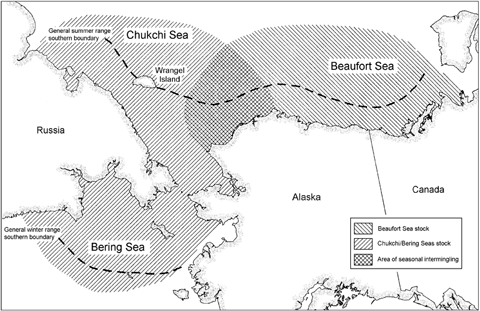Alaska: Inupiaq
Arctic Polar Bear, Ursus maritimus
 Climate change is impacting all parts of the world today, but no regions are being hit harder than the Arctic and
Antarctica. The 2007 Intergovernmental Panel on Climate Change reported that Alaska has seen a 3° C increase
in temperature since the 1970s. Some models suggest the northern polar ice cap will be completely melted during
summer months within a few short decades. The endangered Arctic region serves as critical habitat for endemic species
such as the polar bear that depend on sea ice for survival.
Climate change is impacting all parts of the world today, but no regions are being hit harder than the Arctic and
Antarctica. The 2007 Intergovernmental Panel on Climate Change reported that Alaska has seen a 3° C increase
in temperature since the 1970s. Some models suggest the northern polar ice cap will be completely melted during
summer months within a few short decades. The endangered Arctic region serves as critical habitat for endemic species
such as the polar bear that depend on sea ice for survival.
Sea ice is melting in the north, and with it will likely go polar bear populations. This majestic creature depends
heavily on sea ice, which acts as a platform during the species' prime hunting season in the summer months and provides
a buffer against raging Arctic storms.
Polar bears are poor terrestrial hunters due to the high level of energy expended when walking; as a result, they
depend greatly on aquatic marine life for survival. Polar bears have the capability to swim for extended periods
of time; however, if they do not have a reasonable rest on ice packs or land, polar bears can easily die of
exhaustion; likewise, as sea ice melts away, the bears must swim increasingly long distances from one floe to
another, increasing the likelihood of exhaustion and drowning. The United States Geological Survey and others have
found that numerous polar bear deaths result from starvation and exhaustion.
Polar Bear Habitat Distribution:
Source: http://alaska.fws.gov/fisheries/mmm/polarbear/map.htm
 Polar bears breed during the summer months. Habitat degradation is contributing to declining cub survival rates and unstable
denning conditions. As a survival mechanism, the female bear has the natural ability to abort if her body lacks nutritional
content; this is ultimately leading to a decreasing population growth of a low reproducing species. Further, increasing
temperatures are causing dens to collapse and other disruptions leading to unsuccessful survival rates of cubs. Half of
maternal denning occurs on the ice pack.
Polar bears breed during the summer months. Habitat degradation is contributing to declining cub survival rates and unstable
denning conditions. As a survival mechanism, the female bear has the natural ability to abort if her body lacks nutritional
content; this is ultimately leading to a decreasing population growth of a low reproducing species. Further, increasing
temperatures are causing dens to collapse and other disruptions leading to unsuccessful survival rates of cubs. Half of
maternal denning occurs on the ice pack.
The polar bear is an important part of the food chain of all species in the Arctic, including humans who rely on this food
source as part of their subsistence lifestyle. The communities of Point Hope, Kivalina, Bering Strait/St Lawrence Island,
Barrow, Shishmaref, Atqasuk, and Wainwright are known to hunt and consume polar bears.
In May 2008 the polar bear was listed as a threatened species under the Endangered Species Act. Subsistence harvest of the polar
bear by Alaska Natives is still allowed as it is not deemed to be a threat to the species.
For more information please contact: